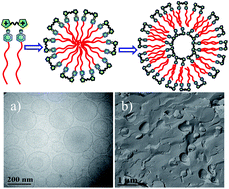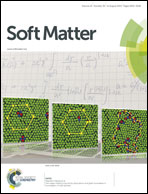Spontaneous vesicle phase formation by pseudogemini surfactants in aqueous solutions†
Abstract
The phase behavior of a kind of pseudogemini surfactant in aqueous solutions, formed by the mixture of sodium dodecyl benzene sulfonate (SDBS) and butane-1,4-bis (methylimidazolium bromide) ([mim-C4-mim]Br2) or butane-1,4-bis(methylpyrrolidinium bromide) ([mpy-C4-mpy]Br2) in a molar ratio of 2 : 1, is reported in the present work. When [mim-C4-mim]Br2 or [mpy-C4-mpy]Br2 is mixed with SDBS in aqueous solutions, one cationic [mim-C4-mim]Br2 or [mpy-C4-mpy]Br2 molecule “bridges” two SDBS molecules by noncovalent interactions (e.g. electrostatic, π–π stacking, and σ–π interactions), behaving like a pseudogemini surfactant. Vesicles can be formed by this kind of pseudogemini surfactant, determined by freeze-fracture transmission electron microscopy (FF-TEM) or cryogenic-transmission electron microscopy (cryo-TEM) and dynamic light scattering (DLS). The mixed system of sodium dodecyl sulfate (SDS) with [mim-C4-mim]Br2 or [mpy-C4-mpy]Br2 was also constructed, and only micelles were observed. We infer that a pseudogemini surfactant is formed under the synergic effect of electrostatic, π–π stacking, and σ–π interactions in the SDBS/[mim-C4-mim]Br2/H2O system, while electrostatic attraction and hydrophobic interactions may provide the directional force for vesicle formation in the SDBS/[mpy-C4-mpy]Br2/H2O system.


 Please wait while we load your content...
Please wait while we load your content...